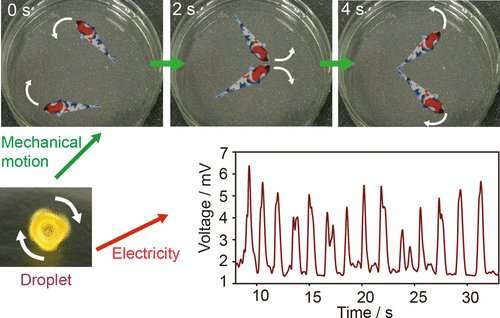Wine 'legs' and minibot motors

As any wine enthusiast knows, the "legs" that run down a glass after a gentle swirl of vino can yield clues about alcohol content. Interestingly, the physical phenomenon that helps create these legs can be harnessed to propel tiny motors to carry out tasks on the surface of water. Scientists demonstrate the motors in a report in ACS' journal Langmuir.
Miniature robots in water have been shown to clean up pollutants and perform other useful tasks. But fueling them has been a challenge. One promising method to propel little machines through water involves using chemical reactions to produce bubbles, which then get ejected and push the robots around. However, this approach requires the use of expensive catalysts. To eliminate the catalysts but still propel the machines on water, Lidong Zhang and colleagues turned to the Marangoni effect in which a fluid moves due to changes in surface tension.
To build their minimotors, the researchers created concentrated droplets of polyvinylidene fluoride (PVDF) and dimethyl formamide (DMF) that, due to the Marangoni effect, rotate rapidly on water. Testing showed that the droplets could propel paper goldfish hundreds of centimeters without emitting any pollutants into the air. Also, with the addition of an electromagnetic generator, the kinetic energy could be converted to electrical energy, a feature that could broaden the propeller's applicability.
More information: Lidong Zhang et al. Marangoni Effect-Driven Motion of Miniature Robots and Generation of Electricity on Water, Langmuir (2017). DOI: 10.1021/acs.langmuir.7b03270
Abstract
This paper describes the development of a thermal transformation process to recycle waste toner powder in a sustainable and environmentally friendly manner. The process leverages high-temperature reactions and the morphology and chemical composition of waste toner powder, mainly the iron oxide and carbon content, by utilizing the gases evolved during the thermal transformation as an in situ source of carbon to convert the waste toner powder into 98% pure iron. A temperature of 1550 °C was employed in the present study to ensure the complete transformation of waste toner powder to iron and also because of its practical relevance to operating conditions encountered in metal manufacturing and processing industries. The process delivers an iron recovery of 81.6%. X-ray diffraction, scanning electron microscopy–energy-dispersive spectroscopy, and inductively coupled plasma optical emission spectroscopy analyses were employed to confirm the composition of the metallic product. GC–MS analysis was utilized to monitor gaseous aromatic compounds during the thermal degradation studies of the waste toner powder, and none were detected above 1200 °C. In addition, this paper presents a comprehensive characterization of the waste toner powder and resultant products using various analytical techniques, a kinetic study of the thermal decomposition of waste toner powder, and a pelletization technique to overcome its material handling hazards.
Journal information: Langmuir
Provided by American Chemical Society




















